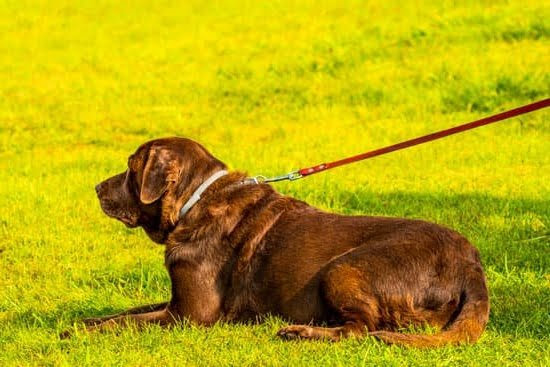Training your dog to stop chasing animals is crucial for their safety and the well-being of other creatures. A dog’s instinct to chase can lead to dangerous situations, causing harm or even fatalities. This article will discuss the importance of obedience and control over your dog’s behavior, as well as the underlying reasons behind their drive to chase.
Dogs have a natural inclination to chase animals due to their ancestral instincts. While it may seem harmless at first, this behavior can result in numerous consequences, ranging from injury to livestock or wildlife, damage to property, or even accidents on roads. By training your dog to suppress this instinct, you can prevent potentially catastrophic incidents and ensure a harmonious coexistence with other animals.
The key lies in establishing obedience and control over your dog’s actions. Basic obedience training forms an essential foundation for managing chasing behavior successfully. It allows you to communicate effectively with your dog and gain their respect and attention. Through proper training techniques, you can teach your dog important commands such as “sit,” “stay,” and “leave it,” which will prove invaluable in redirecting their focus away from chasing animals.
By prioritizing the need for training and obedience in your furry friend, you are taking a proactive step towards preventing unnecessary harm and fostering responsible pet ownership.
In the following sections of this article, we will explore the root causes behind chasing behavior, techniques for positive reinforcement modification, methods of distraction and redirection, the significance of exercise and mental stimulation, professional training options available, real-life case studies, and ultimately conclude with how consistency and patience lead to a well-behaved canine companion that no longer sees animals as prey.
Understanding the Root Cause of the Behavior
When it comes to training your dog to stop chasing animals, it is crucial to first understand the root cause of this behavior. Dogs have an instinctual drive to chase, which can be traced back to their evolutionary ancestry as predators. By analyzing the origins of this behavior and delving into its psychological reasons, we can better address and modify it.
One key aspect to consider is that dogs are descendants of wolves, who are natural hunters. Chasing behavior was essential for their survival as they relied on their hunting skills to obtain food. This instinct has been passed down through generations, even though domesticated dogs may not rely on hunting for survival today.
In addition to genetic factors, there are also psychological reasons behind a dog’s propensity to chase animals. For some dogs, chasing can provide a form of entertainment or mental stimulation. The thrill of pursuit releases dopamine in their brain, reinforcing this behavior and making it difficult to break.
To effectively train your dog to stop chasing animals, it is important to acknowledge these underlying factors and work on modifying them through positive reinforcement techniques and redirecting their energy towards more appropriate behaviors.
The Importance of Basic Obedience Training
Basic obedience training is a crucial aspect of teaching your dog to stop chasing animals. By instilling basic commands in your furry friend, you establish a strong foundation for obedience and control over their behavior. This foundation will be essential in curbing their natural instinct to chase animals and ensuring their safety as well as the safety of other animals they may come across.
One of the fundamental commands that should be taught during obedience training is “leave it.” This command instructs your dog to not engage with or pursue the object or animal they are fixating on. It is crucial to practice this command consistently and reward your dog when they successfully respond by redirecting their attention away from the desired target.
Another important command to teach your dog is “come” or recall. This command helps you regain control over your dog’s actions when they are in pursuit mode. By being able to call them back when they start chasing, you can prevent potential conflicts with other animals, traffic accidents, or any other dangerous situations.
Additionally, incorporating training exercises that focus on impulse control can greatly contribute to reducing chasing behavior. For example, teaching your dog to stay still in the presence of enticing stimuli can help them learn self-control and resist the urge to chase after animals.
By emphasizing basic obedience training, you provide your dog with clear guidelines and boundaries regarding their behavior. With consistent practice and positive reinforcement, these commands become ingrained in their routine and contribute significantly towards reducing their chasing instincts. Remember that patience and consistency are key when training your dog, so continue practicing these commands regularly even after achieving satisfactory results.
- Teach the “leave it” command consistently
- Practice recall exercises regularly
- Incorporate impulse control training exercises
- Emphasize consistency and patience throughout the process
Identifying Triggers and Recognizing Body Language
When it comes to training your dog to stop chasing animals, it is important to be able to identify the triggers that initiate their chasing behavior. By understanding what sets off this instinctual drive in your dog, you can take proactive steps to address the issue. Additionally, recognizing your dog’s body language can provide valuable insights into their mindset and intentions, allowing you to intervene before they have a chance to start chasing.
Identifying Triggers
The first step in addressing your dog’s chasing behavior is identifying the triggers that set them off. These triggers can vary from dog to dog, but common ones include seeing wildlife, encountering small animals like squirrels or rabbits, or even other dogs running by. Take note of situations where your dog seems most likely to chase.
This could be during walks in particular areas or when they are off-leash in certain environments. By pinpointing these triggers, you can then work on desensitizing your dog and gradually reducing their reactivity.
Recognizing Body Language
Your dog’s body language can provide important clues about their state of mind and whether or not they are about to give chase. Some signs that indicate they are getting ready to chase include: a fixed stare at the target animal, forward-leaning posture with weight shifted towards their front legs, raised tail held high and stiff, ears perked forward, and focused attention on the potential prey.
Early recognition of these body language cues is key in interrupting the chasing behavior before it escalates. As soon as you notice any of these signs, try redirecting your dog’s attention using positive reinforcement techniques discussed elsewhere in this article.
Remember that every dog is different and may exhibit unique body language cues associated with their chasing behavior. Observe your own dog closely during various situations and make note of any consistent patterns. This will help you become more adept at recognizing their individual body language signals and effectively intervening in the future.
By becoming skilled at identifying triggers and recognizing your dog’s body language, you will be better equipped to prevent or redirect chasing behavior. This awareness forms an essential foundation as you work towards modifying this instinctual drive in your dog.
Positive Reinforcement Techniques for Behavior Modification
Positive reinforcement techniques are highly effective in training dogs to modify their behavior, including stopping the instinctual drive to chase animals. By utilizing positive reinforcement, dog owners can create a positive association with desirable behaviors and discourage chasing behavior. This section will provide step-by-step instructions on implementing positive reinforcement techniques to discourage chasing animals.
Step 1: Identify an Appropriate Reward
The first step in using positive reinforcement is to identify a reward that holds value for your dog. This could be a favorite treat, a special toy, or verbal praise. It’s important to choose a reward that your dog finds truly enjoyable and motivating. Every dog is different, so it may take some trial and error to find the perfect reward.
Step 2: Establish the Desired Behavior
Once you have identified an appropriate reward, it’s time to establish the desired behavior. In this case, the goal is for your dog to refrain from chasing animals. Begin by setting up controlled scenarios where your dog is likely to see an animal but has not yet started chasing.
As soon as you notice your dog showing self-control and choosing not to chase, immediately give them the reward along with verbal praise. This helps reinforce the idea that not chasing animals leads to something wonderful.
Step 3: Consistency is Key
Consistency is crucial when using positive reinforcement techniques. It’s essential to reward your dog every single time they choose not to chase an animal during training sessions. This consistency will help reinforce the desired behavior and increase the likelihood of long-term success.
Step 4: Generalize the Behavior
After your dog consistently demonstrates self-control during controlled training sessions, begin generalizing the behavior in different environments and situations. Gradually expose your dog to increasingly challenging scenarios where they may encounter animals but continue displaying restraint from chasing. Remember always to provide rewards and praise whenever your dog successfully resists the urge to chase.
Using positive reinforcement techniques for behavior modification is a powerful tool in training your dog to stop chasing animals. By consistently rewarding and reinforcing the desired behavior, you can help your dog override their instinct to chase and create new habits. However, it’s essential to be patient during this process, as every dog learns at their own pace. Stay consistent and persistent, and eventually, you will have a well-behaved dog that no longer chases animals.
Distracting and Redirecting Attention
In the process of training your dog to stop chasing animals, one effective technique is to distract and redirect their attention. By providing alternative stimuli or commands, you can help your dog break their focus on chasing behavior and redirect it elsewhere. This section will present various distraction techniques and provide examples of toys, treats, and commands that can effectively redirect your dog’s attention.
To distract your dog from their usual chase instinct, you can introduce them to interactive toys or games that require mental engagement. Puzzle toys, for example, can keep your dog’s mind occupied and divert their attention away from animals. These toys often involve hiding treats or challenging them to solve puzzles in order to access rewards.
Another effective way to distract your dog is by using high-value treats or toys as a reward. When you notice your dog showing interest in chasing an animal, immediately offer them a treat or toy that they find highly rewarding. By associating the desired behavior (not chasing) with a positive reward, you are reinforcing the idea that focusing on you or engaging in other activities is more rewarding than chasing animals.
Additionally, teaching your dog specific commands like “sit,” “stay,” or even “leave it” can be instrumental in redirecting their attention when they are about to chase an animal. Practice these commands regularly during training sessions and gradually introduce distractions such as other animals or exciting scents. When your dog successfully responds to these commands in the presence of distractions, reward them generously with praise and treats.
By consistently implementing distraction techniques and providing appropriate redirection options for your dog’s attention, you can effectively discourage chasing behavior. Remember that each dog is different, so it may take some trial and error to find what works best for your furry companion. Patience and consistency are key throughout this training process.
| Distraction Technique | Example |
|---|---|
| Interactive toys | Puzzle toys that require mental engagement, hiding treats for your dog to find |
| High-value rewards | Treats or toys that your dog finds highly rewarding, offered immediately when they show interest in chasing animals |
| Specific commands | “Sit,” “stay,” “leave it,” practiced regularly during training sessions and reinforced with rewards when successfully performed in the presence of distractions |
The Role of Proper Exercise and Mental Stimulation
Proper exercise and mental stimulation play a crucial role in training your dog to stop chasing animals. Dogs have innate instincts to hunt and chase, so it is important to provide them with appropriate outlets for these natural behaviors. Insufficient exercise and mental stimulation can lead to pent-up energy and frustration, which may manifest in chasing behavior. By ensuring that your dog gets enough physical exercise and mental stimulation, you can help prevent excessive chasing behavior.
Physical exercise is essential for dogs as it helps release their excess energy and provides an outlet for their natural instincts. Regular walks or runs, playing fetch, or engaging in activities such as agility training or swimming can help tire out your dog both physically and mentally. This not only reduces the likelihood of them seeking out animals to chase but also improves their overall well-being.
Mental stimulation is just as important as physical exercise for dogs. Canine companions require mental challenges and enrichment to keep their minds engaged. Providing puzzle toys, interactive games, obedience training sessions, or teaching new tricks are excellent ways to mentally stimulate your dog. These activities help satisfy their need for mental engagement and can reduce boredom-induced chasing behaviors.
| Benefit of Proper Exercise | Benefit of Mental Stimulation |
|---|---|
| Helps release excess energy | Keeps the dog’s mind engaged |
| Provides an outlet for natural instincts | Reduces boredom-induced behaviors |
| Promotes overall well-being | Satisfies the need for mental challenges |
In addition to helping curb chasing behavior, regular exercise and mental stimulation contribute to a healthier bond between you and your furry friend. These activities strengthen the trust and connection between you, improve your dog’s overall obedience, and make them more receptive to training commands. It is essential to find a balance between physical exercise and mental stimulation that suits your dog’s breed, age, and energy level.
By incorporating proper exercise and mental stimulation into your dog’s routine, you are setting them up for success in their training journey. Remember to consult with your veterinarian before starting any new exercise regimen or mental stimulation activities to ensure they are suitable for your dog’s specific needs and health conditions. With consistent effort and dedication, you can greatly reduce your dog’s chasing behavior while enhancing their overall well-being.
Professional Training Options and Resources
While basic obedience training and positive reinforcement techniques can be effective in curbing a dog’s chasing behavior, there may be instances where professional training help is needed. Professional trainers have the expertise to deal with more challenging cases and can provide additional tools and strategies for modifying the behavior.
One option for professional help is enrolling your dog in a training class or program. Training centers offer structured classes that focus on specific behavioral issues, including chasing animals. These classes typically involve both group and individual sessions, providing an opportunity for your dog to socialize with other dogs while learning how to control their chasing impulses.
Another resource to consider is online training programs. Many trainers offer virtual courses where you can learn from the comfort of your own home. These programs often include step-by-step instructional videos, resources, and personalized guidance from the trainer to address your specific training needs.
Books are also valuable resources when it comes to understanding and addressing your dog’s chasing behavior. Look for books written by renowned dog trainers or behaviorists that specifically tackle the issue of animal chasing. These books will provide you with comprehensive insights into the root causes of this behavior as well as practical advice on how to train your dog effectively.
Additionally, there are various online forums and communities dedicated to dog training where you can seek advice from experienced dog owners and professionals alike. These platforms offer a supportive environment where you can share your challenges, ask questions, and receive valuable tips from individuals who have successfully trained their dogs not to chase animals.
By utilizing professional training options and resources, you can enhance your understanding of your dog’s chasing behavior and access expert guidance tailored to your specific situation. Remember that every dog is unique, and what works for one may not work for another. Be open-minded, patient, and willing to adjust your approach as needed in order to achieve success in training your dog to stop chasing animals.
Case Studies and Success Stories
One of the most effective ways to understand how to train your dog to stop chasing animals is to learn from real-life case studies and success stories. These examples can provide inspiration and practical insights into the training techniques that have proven successful in different scenarios.
For example, Sarah, a dog owner from California, was struggling with her Australian Shepherd’s intense desire to chase squirrels during walks. She implemented positive reinforcement techniques by using treats and praise whenever her dog showed self-control and ignored the squirrels. Gradually, Sarah noticed her dog’s behavior changing, as he became more focused on her commands rather than the tempting distractions. Today, Sarah’s Australian Shepherd is able to walk calmly past squirrels without attempting to chase them.
Another success story comes from Mark, who owned a Border Collie with a strong prey drive. He recognized that his dog’s instinctual need for mental stimulation was a contributing factor to the chasing behavior.
In addition to obedience training, Mark started engaging his dog in activities that provided both physical exercise and mental challenges like puzzle toys and agility training. Through consistent exercise and mental stimulation, Mark noticed a significant reduction in his Border Collie’s inclination to chase animals.
These case studies demonstrate that each dog is unique, requiring tailored approaches based on their personality and instinctual drives. They also highlight the importance of consistency in training efforts along with positive reinforcement techniques. By understanding these success stories, dog owners can gain valuable insight into how they can address their own dog’s chasing behavior.
By learning from others who have successfully trained their dogs to stop chasing animals, readers can gain confidence in their own abilities as trainers. It is important to remember that every journey will be different and may require patience and perseverance. However, with dedication and the application of proven techniques learned from case studies like these, you too can achieve success in modifying your dog’s chasing behavior.
Conclusion
In conclusion, training your dog to stop chasing animals is not only crucial for the safety and well-being of other animals, but also for the obedience and control of your own pet. Throughout this article, we have discussed various aspects of dog behavior, understanding the root causes of their instinct to chase, and implementing effective training techniques.
One key takeaway from this article is the importance of consistency and patience in the training process. Changing a dog’s behavior takes time and effort, and it is essential to remain consistent in your approach. By consistently using positive reinforcement techniques and redirecting their attention whenever they show signs of wanting to chase, you can gradually modify their behavior over time.
It is also important to remember that each dog is unique, and what works for one might not work for another. This is why patience plays a critical role in training. Some dogs may require more time or different methods to fully grasp the concept of not chasing animals. Patience allows you to adapt your training approach as needed and ensures that you don’t become frustrated or discouraged.
Ultimately, the reward of a well-behaved dog that doesn’t chase animals far outweighs the challenges faced during training. A dog that understands how to control their hunting instincts not only becomes a safer companion but also brings joy and peace of mind to their owner. So stay committed, be patient, and enjoy the lifelong benefits that come with having a well-trained dog by your side.
Frequently Asked Questions
How do I get my dog to stop chasing animals?
To get your dog to stop chasing animals, it’s important to understand that this behavior often stems from their natural prey drive. The first step is establishing a solid foundation of obedience training with your dog, ensuring they respond well to basic commands such as “sit,” “stay,” and “come.” Once you have established this foundation, you can work on specific commands tailored to deter chasing, such as teaching them the command “leave it” or “no chase.”
Consistency is key when reinforcing these commands, and using positive reinforcement techniques like treats, praise, and playtime can be highly effective. Additionally, providing mental and physical stimulation through regular exercise and appropriate toys can help redirect some of their excess energy that may contribute to their desire to chase animals.
How do I train my dog not to chase wild animals?
Training a dog not to chase wild animals follows a similar approach as stopping them from chasing any animals. One crucial aspect is teaching them impulse control. This can be done through exercises like supervised exposure to controlled situations where they encounter wildlife but are taught to remain calm and controlled.
It’s essential to gradually increase the difficulty level of these exercises so that your dog learns how to restrain their instinctual responses in increasingly challenging scenarios. Always emphasize positive reinforcement for good behavior during these training sessions instead of punishment or scolding. Additionally, proper socialization with other dogs that are not prone to chasing wild animals can also be beneficial in curbing this behavior.
Can prey drive be trained out of a dog?
While prey drive is an inherent instinct in many dogs, it can be managed and trained within acceptable boundaries rather than completely eliminating it altogether. It’s important to understand that prey drive cannot be entirely removed since it is a normal part of a dog’s natural behavior. However, through consistent training and reinforcement methods mentioned earlier, such as teaching obedience commands like “leave it” or “drop it,” you can channel your dog’s prey drive into more acceptable behaviors or redirect their focus when faced with temptation.
Training classes or working with a professional dog trainer who specializes in behavior modification can also help you effectively manage your dog’s prey drive and instill good habits. Nonetheless, it’s important to recognize and respect your dog’s innate instincts while maintaining control and ensuring the safety of other animals in the process.

Welcome to the blog! I am a professional dog trainer and have been working with dogs for many years. In this blog, I will be discussing various topics related to dog training, including tips, tricks, and advice. I hope you find this information helpful and informative. Thanks for reading!





